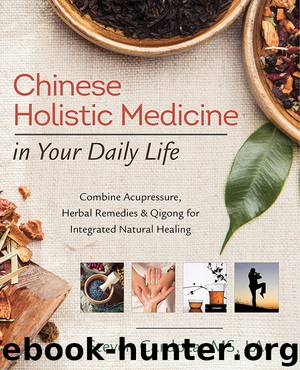Chinese Holistic Medicine in Your Daily Life by Steven Cardoza

Author:Steven Cardoza
Language: eng
Format: epub
Tags: chinese healing, holistic medicine, chinese holistic medicine chinese medicine in your daily life, acupressure, herbalism, qi gong, qigong, stephen cardoza, steven cordoza, stephen cordoza
Publisher: Llewellyn Publications is an imprint of Llewellyn Worldwide Ltd.
Published: 2016-12-20T16:00:00+00:00
[contents]
Chapter 11
Tools and Practice of Chinese Medicine:
Holism and Integration
Each individual Chinese medical practice is holistic, treating the patient and not the disease. Each is very versatile yet has a main focus and strength. For that reason, most acupuncturists, Qigong doctors, and Tuina practitioners include herbs in their practice. Many Qigong and Taiji instructors teach their students and patients about lifestyle and dietary factors, and some offer acupressure or Tuina treatments. Not every physician integrates or even practices all modalities, but to get the fastest, most comprehensive resolution to a health problem or to live the healthiest possible life into a vital old age, all should be included and conscientiously integrated to best support each individual regularly, as is most often done in China. That will become more apparent as you proceed through the following chapters.
Acupuncture
Acupuncture is the art and science of encouraging the body to improve function and promote natural healing by inserting very fine surgical-grade stainless steel needles (see Appendix 2, Note 11.1) into select acupoints found along discrete, well-defined energy pathways called meridians. The diagnostic methods discussed in Chapter 10 are used to identify patterns of disharmony, and points are selected accordingly to restore the body to healthy balance by influencing the flow of Qi within the meridians and their related organs.
Each point has specific functions. The primary point functions usually relate to the function of the organ associated with the selected meridian or to the condition of the meridian itself, which can have its own related set of indications. No organ is ever needled directly. Examples of point functions for nearly one hundred points are found in Chapter 13.
Acupuncture’s main strength is in moving Qi. The ways in which it moves Qi and for what purposes are discussed in the next two sections. Acupuncture on its own does not add Qi to the body. (By using the adjunctive therapy of moxibustion, Yang Qi can be added.) It builds Qi by strengthening the functions of the organs that are responsible for acquiring and producing Qi, primarily the Lungs and Spleen, so a treatment may feel immediately energizing, while building sustainable energy over time. More commonly, patients feel calm and relaxed. Acupuncture moves Blood by moving Qi, which is the commander of Blood. Acupuncture builds Blood by strengthening the functions of the organs that generate Blood, primarily the Spleen and Heart.
Needling Sensations: Deqi
It is a common misunderstanding that there is no sensation associated with acupuncture treatments. In fact, some sensation is required in order for the treatment to be most successful. The needling sensation is called Deqi (De Qi), or the “arrival of the Qi,” and indicates that the Qi has been accessed.
For the physician, Deqi feels like a grabbing around the needle at the site of its insertion. Then the needle can be most effectively manipulated, guiding the Qi to produce a variety of effects and providing the best therapeutic outcomes.
For the patient, typical Deqi sensations include feelings of distension, heaviness, tingling, electricity, temperature change, internal motion, and tightness, among many other possibilities.
Download
This site does not store any files on its server. We only index and link to content provided by other sites. Please contact the content providers to delete copyright contents if any and email us, we'll remove relevant links or contents immediately.
Becoming Supernatural by Dr. Joe Dispenza(8127)
Crystal Healing for Women by Mariah K. Lyons(7857)
The Witchcraft of Salem Village by Shirley Jackson(7193)
Inner Engineering: A Yogi's Guide to Joy by Sadhguru(6728)
The Four Agreements by Don Miguel Ruiz(6639)
The Power of Now: A Guide to Spiritual Enlightenment by Eckhart Tolle(5610)
Secrets of Antigravity Propulsion: Tesla, UFOs, and Classified Aerospace Technology by Ph.D. Paul A. Laviolette(5311)
The Wisdom of Sundays by Oprah Winfrey(5087)
Room 212 by Kate Stewart(5041)
Pale Blue Dot by Carl Sagan(4917)
Fear by Osho(4662)
The David Icke Guide to the Global Conspiracy (and how to end it) by David Icke(4629)
Animal Frequency by Melissa Alvarez(4399)
Rising Strong by Brene Brown(4380)
How to Change Your Mind by Michael Pollan(4292)
Sigil Witchery by Laura Tempest Zakroff(4181)
Real Magic by Dean Radin PhD(4075)
Man and His Symbols by Carl Gustav Jung(4070)
The Art of Happiness by The Dalai Lama(4063)
